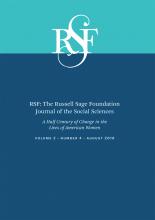Research Article
Open Access
Explaining the Gender Wage Gap in STEM: Does Field Sex Composition Matter?
Katherine Michelmore, Sharon Sassler
RSF: The Russell Sage Foundation Journal of the Social Sciences August 2016, 2 (4) 194-215; DOI: https://doi.org/10.7758/RSF.2016.2.4.07
Katherine Michelmore
aAssistant professor in the Department of Public Administration and International Affairs at Syracuse University
Sharon Sassler
bProfessor in the Department of Policy Analysis and Management at Cornell University

REFERENCES
- ↵Beede, David N., Tiffany Julian, David Langdon, George McKittrick, Beethika Khan, and Mark Doms. 2011. “Women in STEM: A Gender Gap to Innovation.” ESA Issue Brief no. 04–11. Washington: U.S. Department of Commerce, Economics and Statistics Administration.
- ↵Bertrand, Marianne, Claudia Goldin, and Lawrence F. Katz. 2009. “Dynamics of the Gender Gap for Young Professionals in the Corporate and Financial Sectors.” NBER working paper no. 14681. Cambridge, Mass.: National Bureau of Economic Research.
- ↵
- Blau, Francine D., and
- Lawrence M. Kahn
- ↵
- Blau, Francine D., and
- Lawrence M. Kahn
- ↵
- ↵
- Budig, Michelle J., and
- Paula England
- ↵
- Cohen, Philip N., and
- Matt L. Huffman
- ↵
- Cohen, Philip N., and
- Matt L. Huffman
- ↵Committee on Maximizing the Potential of Women in Academic Science and Engineering and Committee on Science Engineering and Public Policy (Committee on Maximizing the Potential of Women). 2006. Beyond Bias and Barrier: Fulfilling the Potential of Women in Academic Science and Engineering. Washington, D.C.: National Academies Press.
- ↵
- Cotter, David A.,
- JoAnn DeFiore, ,
- Joan M. Hermsen, ,
- Brenda Marsteller Kowalewski, , and
- Reeve Vanneman
- ↵DiPrete, Thomas A., and Claudia Buchmann. 2013. The Rise of Women: The Growing Gender Gap in Education and What It Means for American Schools. New York: Russell Sage Foundation.
- ↵
- ↵
- Glass, Jennifer L.,
- Sharon Sassler, ,
- Yael Levitte, , and
- Katherine M. Michelmore
- ↵Goldin, Claudia. 2002. “A Pollution Theory of Discrimination: Male and Female Differences in Occupations and Earnings.” NBER working paper no. 8985. Cambridge, Mass.: National Bureau of Economic Research.
- ↵
- ↵
- Goldin, Claudia,
- Lawrence F. Katz, , and
- Ilyana Kuziemko
- ↵Hakim, Catherine. 2000. Work-Lifestyle Choices in the 21st Century: Preference Theory. Oxford: Oxford University Press.
- ↵
- ↵Hill, Catherine, Christianne Corbett, and Andresse St. Rose. 2010. Why So Few? Women in Science, Technology, Engineering, and Mathematics. Washington, D.C.: American Association of University Women. Accessed April 6, 2016. https://www.aauw.org/files/2013/02/Why-So-Few-Women-in-Science-Technology-Engineering-and-Mathematics.pdf.
- ↵
- Huffman, Matt L., and
- Steven C. Velasco
- ↵
- Jacobsen, Joyce P
- ↵
- ↵
- Levanon, Asaf,
- Paula England, , and
- Paul Allison
- ↵
- ↵
- Mandel, Hadas
- ↵
- ↵
- ↵
- Morgan, Laurie A
- ↵Pew Research Center. 2013. “On Pay Gap, Millennial Women Near Parity—For Now.” Washington, D.C.: Social & Demographic Trends Project. Accessed April 6, 2016. http://www.pewsocialtrends.org/2013/12/11/on-pay-gap-millennial-women-near-parity-for-now/.
- ↵
- Prokos, Anastasia, and
- Irene Padavic
- ↵
- Roos, Patricia A., and
- Barbara F. Reskin
- ↵
- ↵Sassler, Sharon, Jennifer L. Glass, Yael Levitte, and Katherine M. Michelmore. 2011. “The Missing Women in STEM? Accounting for Gender Differences in Entrance into Science, Technology, Engineering, and Math Occupations.” Presented at the 2012 Population Association of America annual meeting, Washington, D.C. (September 19, 2011).
- ↵
- Stähli, Michèle Ernst,
- Jean-Marie Le Goff, ,
- René Levy, , and
- Eric Widmer
- ↵Xie, Yu, and Kimberlee A. Shauman. 2003. Women in Science: Career Processes and Outcomes. Cambridge, Mass.: Harvard University Press.
In this issue
Explaining the Gender Wage Gap in STEM: Does Field Sex Composition Matter?
Katherine Michelmore, Sharon Sassler
RSF: The Russell Sage Foundation Journal of the Social Sciences Aug 2016, 2 (4) 194-215; DOI: 10.7758/RSF.2016.2.4.07
Jump to section
Related Articles
- No related articles found.





